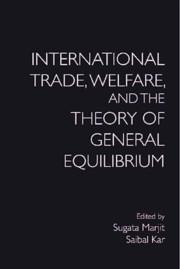Book contents
- Frontmatter
- Contents
- List of Figures and Tables
- Introduction
- 1 Thoughts and Remarks after 50 Years of Simple General Equilibrium Models
- 2 Adjustment Costs and Trade Liberalization
- 3 Farsightedly Stable FTA Structures: The Roles of Preexisting Tariff Rates
- 4 Skilled–Unskilled Wage Inequality and Dynamic Skill Accumulation: A Theoretical Analysis
- 5 FDI in Education vs FDI in Commodity Production: A Theoretical Model
- 6 Skilled Migration and Foreign Aid in a General Equilibrium Model of Monopolistic Competition
- 7 Trade, Factor Flows, and Product Variety in a Small Open Economy
- 8 Product Differentiation, Quality of Innovation, and Capital Mobility: A General Equilibrium Analysis
- 9 Cross-Border Mergers and International Trade: A Vertical GOLE Model
- 10 International Trade and Production Organization: A Review of Contemporary Literature
- 11 Negative Production Externalities, Labor Market Imperfection, and Production Tax Policy in a Developing Economy
- 12 Tax-Financed Public Transfers: A Mechanism for Double Taxation
- Contributors
- Index
2 - Adjustment Costs and Trade Liberalization
Published online by Cambridge University Press: 01 November 2018
- Frontmatter
- Contents
- List of Figures and Tables
- Introduction
- 1 Thoughts and Remarks after 50 Years of Simple General Equilibrium Models
- 2 Adjustment Costs and Trade Liberalization
- 3 Farsightedly Stable FTA Structures: The Roles of Preexisting Tariff Rates
- 4 Skilled–Unskilled Wage Inequality and Dynamic Skill Accumulation: A Theoretical Analysis
- 5 FDI in Education vs FDI in Commodity Production: A Theoretical Model
- 6 Skilled Migration and Foreign Aid in a General Equilibrium Model of Monopolistic Competition
- 7 Trade, Factor Flows, and Product Variety in a Small Open Economy
- 8 Product Differentiation, Quality of Innovation, and Capital Mobility: A General Equilibrium Analysis
- 9 Cross-Border Mergers and International Trade: A Vertical GOLE Model
- 10 International Trade and Production Organization: A Review of Contemporary Literature
- 11 Negative Production Externalities, Labor Market Imperfection, and Production Tax Policy in a Developing Economy
- 12 Tax-Financed Public Transfers: A Mechanism for Double Taxation
- Contributors
- Index
Summary
Events such as the negotiation of international trade agreements and the entry of China into international markets may require a significant reallocation of resources in a country. The reallocation is from import-competing sectors to exportable sectors. For example, Carneiro (2014) finds that adjustment costs in Brazil could represent between 14 and 42 per cent of the gains from trade, and that the adjustment process can take five years or longer. The question of how economic policy can be used to facilitate this reallocation is important. This is so because ineffective management of the transition can undercut the gains from trade liberalization and undermine the political support currently seen for international trade.
The purpose of this chapter is to characterize the optimal path for tariff rates following the negotiation of a trade agreement between two countries, wherein each country incurs costs for moving resources from import-competing to exportable sectors. It is assumed that these countries can commit to a path for tariffs in the agreement, and that their governments have chosen policies to maximize national welfare. The question we address is as to what form the phase-in period for tariff reductions should take. At one extreme end is the ‘big bang’ approach, which has been advocated for transition economies. This approach would call for tariffs to be eliminated immediately once an agreement is signed. The alternative is a gradualist approach, which has been the approach more frequently applied in trade agreements. In this approach, the agreed tariff reductions are phased in over a pre-specified period. The analysis in this chapter will focus on how the answer to this question depends on the efficiency of the adjustment process in the countries.
The model analyzed in this chapter is one in which factors located in the import-competing and exportable sectors are fixed in the short run, but can move between sectors in the long run by incurring a resource cost for moving between sectors. The short-run model is similar to the specific factors model of international trade, which was presented in the classic paper by Ronald Jones (1971), and has become the workhorse model in the political economy of trade literature. The model presented herein adds a dynamic element by considering the relocation decision of workers between sectors and allowing for heterogeneity in the tradable goods sectors.
- Type
- Chapter
- Information
- Publisher: Cambridge University PressPrint publication year: 2018



